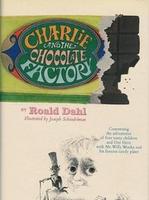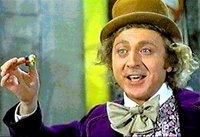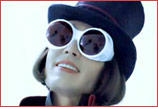Is it a Good Nut or a Bad Nut?

What happens when you combine the work of Roald Dahl, Johnny Depp, and Tim Burton? A world of pure imagination. I grew up loving the 1971 version of Willy Wonka and the Chocolate Factory and the dazzling performance Gene Wilder brought to the film. The idea of a remake left me with doubts. When th
 e news hit that it was to be produced by Tim Burton, I was relieved, certain that he'd bring to the screen the wonders the book unfolds, and there was no doubt his own brand of strangeness would only serve to add to the masterpiece crafted by Roald Dahl, a writer who amuses and intrigues me in much the same way.
e news hit that it was to be produced by Tim Burton, I was relieved, certain that he'd bring to the screen the wonders the book unfolds, and there was no doubt his own brand of strangeness would only serve to add to the masterpiece crafted by Roald Dahl, a writer who amuses and intrigues me in much the same way.I watched the 2005 film, Charlie and the Chocolate Factory, in a theatre last night and was hypnotised by the details. I loved that both films opened with the making of the chocolate and the Burton film takes it a step further by packaging them and sending them out in these sharp little vans that look vintage and modern in their own snappy red way, as is the stylistic choice of the film at nearly every turn. Everything was synchronized in a way only found in perfect worlds. I had visions of Edward Scissorhand's suburban neighborhood and the immaculate lawns. Still in that world, Johnny Depp played a man who lived alone in darkness and chaos set apart... In this film, Depp's Wonka seems to live in very organized, perfectly orchestrated wonder. He is god-like in the way of imaginative creation and even appears to be a little omnipotent. This is somewhat demonstrated by the Oopma Loompa's song and dance numbers that, while claiming to be improptu, seem to be rather rehearsed with the names of the unfortunate children and details of their ugly little lives. Each performance given moments after the child makes an error that removes him or her from the action. The lyrics in the new movie are straight from the book, but the performances are entertaining and display a variety of musical styles to accompany the words. In the 1971 version, the Oompa Loompa's left their mark in a similar way. Though the songs stood out less since the entire film was sprinkled with musical numbers--a fact I didn't recall until I watched it again on DVD.... last night after I returned from the theatre.
While I can't begin to say which film was better, I will say there are elements in each I prefer, and in each film there are elements of the book... at times, lines lifted straight from the pages. In the 2005 version, Charlie has a father who works at the toothpaste factory, as he does in the book, and their poverty seems evident in the way I imagined it when I read the tale so long ago. In fact, I loved the performances of Helena Bonham Carter and Noah Taylor who p
 lay the parents of Charlie. In the 1971 film, Charlie no longer has a father and it's his mother who must eke out a living for the family. In all three versions there are four grandparents bedridden in the same bed delighting in the presence of Charlie. And who wouldn't, for he, in every version, is a delightful, sweet, generous boy. Charlie Bucket is played by Freddie Highmore in the 2005 version. What is funny is Highmore (introduced in another wonderful Johnny Depp Film Finding Neverland), looks as if he could be the model for James as he appears in Tim Burton's rendition of James and the Giant Peach, another classic by Roald Dahl.
lay the parents of Charlie. In the 1971 film, Charlie no longer has a father and it's his mother who must eke out a living for the family. In all three versions there are four grandparents bedridden in the same bed delighting in the presence of Charlie. And who wouldn't, for he, in every version, is a delightful, sweet, generous boy. Charlie Bucket is played by Freddie Highmore in the 2005 version. What is funny is Highmore (introduced in another wonderful Johnny Depp Film Finding Neverland), looks as if he could be the model for James as he appears in Tim Burton's rendition of James and the Giant Peach, another classic by Roald Dahl.The other children are equally awful in every version of the tale. My favorite has to be Veruca Salt, though I think as a youth I really loved the idea of the gum-chewing Violet turning into a blueberry. The person who seems the most different between the film versions has to be Willy Wonka, himself. Roald Dahl's creation seems a bit more like the man played by Gene Wilder. Compassionate, clever, and in the end rather kind. I think that Dahl's character seems less mad than Wilder portrays him. But that even seems an
 illusion. Wilder's Wonka seems to be tolerant. He humors the idiotic behavior of the children and their equally ridiculous parents, yet he proceeds in his world efficient and businesslike without pity or fear. Often you hear him offering quips and snippets of wisdom, at choice moments when the rest of us would like to say... behave! His eyes twinkle and his comments to others shock and horrify all of them except Charlie who seems to be able to see beyond the guise and straight into the far too sane heart of a genius.
illusion. Wilder's Wonka seems to be tolerant. He humors the idiotic behavior of the children and their equally ridiculous parents, yet he proceeds in his world efficient and businesslike without pity or fear. Often you hear him offering quips and snippets of wisdom, at choice moments when the rest of us would like to say... behave! His eyes twinkle and his comments to others shock and horrify all of them except Charlie who seems to be able to see beyond the guise and straight into the far too sane heart of a genius.Depp's portrayal of Willie Wonka seems more crazy without the sane center. Sometimes you seem like a nut... sometimes you
 just are. Even in the end one sees this Wonka as a man who is creative, lonely, and in need of saving more than Charlie ever was. This version paints a back story for Wonka that doesn't exist in either the 1964 book or the 1971 movie. This story is told in flashback, along with several others which actually do come straight from the pages of Dahl's novel. The story of Prince Pondicherry, the story of the spies who were stealing Wonka's recipes, the story of where the Oompa Loompa's came from down to the detail of the caterpillars they mashed up to eat.... each one of those were a welcome addition to the film that the '71 version omitted. Depp's Wonka feels less friendly and more "I know you are but what am I" than the man portrayed by Wilder. He's not even interested in the names of the children and doesn't seem to be aware of the fact that the number has dwindled to just Charlie at one point. While it isn't necessarily bad, I tend to prefer the Wilder way. I will say Depp a
just are. Even in the end one sees this Wonka as a man who is creative, lonely, and in need of saving more than Charlie ever was. This version paints a back story for Wonka that doesn't exist in either the 1964 book or the 1971 movie. This story is told in flashback, along with several others which actually do come straight from the pages of Dahl's novel. The story of Prince Pondicherry, the story of the spies who were stealing Wonka's recipes, the story of where the Oompa Loompa's came from down to the detail of the caterpillars they mashed up to eat.... each one of those were a welcome addition to the film that the '71 version omitted. Depp's Wonka feels less friendly and more "I know you are but what am I" than the man portrayed by Wilder. He's not even interested in the names of the children and doesn't seem to be aware of the fact that the number has dwindled to just Charlie at one point. While it isn't necessarily bad, I tend to prefer the Wilder way. I will say Depp a nd Burton bring style to Willy Wonka though... particularly in the eyewear department. And the way the opening number "Willy Wonka" (figures singing Disneyland style) ends is so distinctly Tim Burton, that I could barely suppress a chuckle. I love how Depp's Wonka comments on the action standing beside them admiring his own show erupting in flames to the horror of the five children.
nd Burton bring style to Willy Wonka though... particularly in the eyewear department. And the way the opening number "Willy Wonka" (figures singing Disneyland style) ends is so distinctly Tim Burton, that I could barely suppress a chuckle. I love how Depp's Wonka comments on the action standing beside them admiring his own show erupting in flames to the horror of the five children.When it comes to the candy, Dahl's book still wins, hands down. There are so many references to wonderful treats, rooms full of delights, unusual and creative candy concepts that either film would need to be expanded to twice its length to properly capture them. The bird's egg candy that opened to reveal a tiny bird on the tongue shown in the 2005 version's flashback to Wonka's first candy shop is a favorite. But I also love the lickable wallpaper in the 1971 version. The Chocolate Room is wonderful in each film and I think made just a little better by the striking color in the Burton film. I long to taste a blade of that "eatable" grass or sample any one of the tantalizing goodies.
In some ways Burton's version follows the book a little more by creating a glass elevator the way it is pictured in the book and by creating the pink horseshoe boat powered by Oompa Loompa's who don't know where they're going. In the 1971 version frightening pictures flash on the walls as they speed past in their boat. Never having noticed this before it really struck me. I have no explanation for this bit of the film except to suggest it is another effort to play with the madness of Wilder's Wonka. In some ways it fits the style of the era as do the Oompa Loompa song sequences.
Should you see this film? Definitely. And if you've never read the book, perhaps you should begin there. It's possible you might want to watch the 1971 version and then proceed to this one. I think each stands alone and yet they can all work together as well. The 1971 version takes from the novel and invents too. It adds to the drama and creates more tension in the ending... Charlie isn't quite perfect in this film. Then the 2005 version remembers bits of the book forgotten in '71 and it also takes from the previous film as well. The character of Willy Wonka takes Wilder's efforts to a whole new level of wacky and then it invents a deeper look into the chocolate madman and candycoated genius. I loved it all. And I'm sure you will too. Be sure to have some candy on hand, it's hard to watch either of these without a sweet treat nearby.
--Kate

0 Comments:
Post a Comment
<< Home